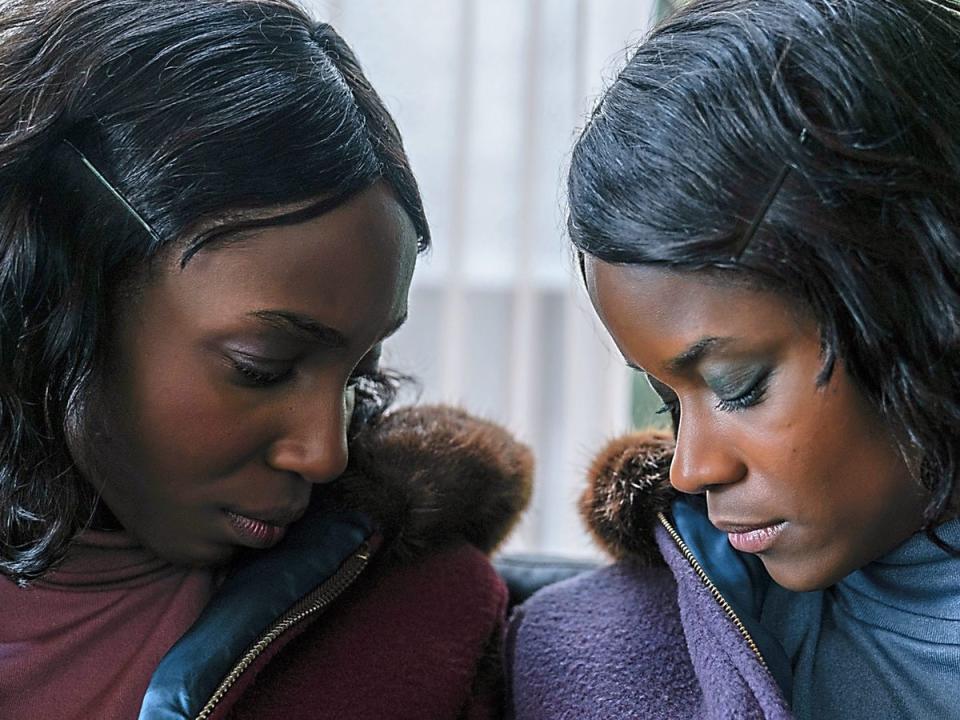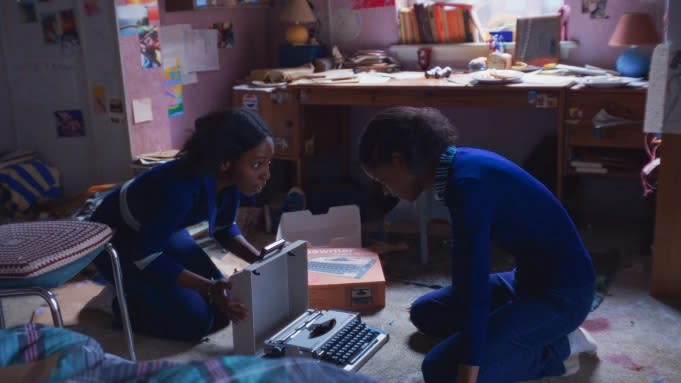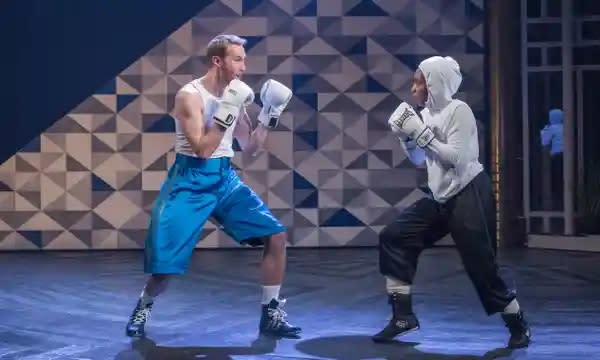How Tamara Lawrance Found Her Voice In ‘The Silent Twins’ & Hot Crime Noir Series ‘Get Millie Black’
- Oops!Something went wrong.Please try again later.
- Oops!Something went wrong.Please try again later.
- Oops!Something went wrong.Please try again later.

EXCLUSIVE: Silence has been golden for Tamara Lawrance who, paired with Wakanda Forever’s Letitia Wright in The Silent Twins, won the best joint lead performance trophy at the recent BIFA awards.
In director Agnieszka Smoczyńska’s picture they portray inseparable twins, Jennifer and June Gibbons, born to Barbadian parents in 1963. They made an unusual pact at an early age to remain speechless except for communicating with each other in an indecipherable dialect of their own design.
More from Deadline
It’s a contrast to a TV drama Lawrance will star in next year, in which she plays a character with more than enough to say. She’s referring to the title role in Channel 4 and HBO’s six-part prestige series Get Millie Black, a crime noir thriller set in Kingston, Jamaica and the UK, created by writer Marlon James whose novel A Brief History of Seven Killings won him the 2015 Man Booker prize.
“The storytelling’s amazing,” Lawrance tells us of Get Millie Black. She stars as a belligerent (her word) ex-Scotland Yard detective who is back in Jamaica working for the local police on a missing person case “that kind of takes us somewhere that she was not expecting to go, physically but also into herself as well”.
The Silent Twins takes us on an unexpected journey as well. “I have people saying to me, ’Oh, yeah, I knew this story but I didn’t know this story. We have a different perspective that opposes the depiction of them in the media that hopefully allows us to sort of analyse a few home truths about the criminal justice system and also to empathize with people that we had previously vilified and ostracised,” says Lawrance, who plays Jennifer.
“I think the expectation was that the film would be more like a thriller but it incorporates a lot of different genres,” says Lawrance, who explains that some scenes employ fantastical animation inspired by the dolls, illustrations and writings created by the sisters.
The film centres on the harsh price the siblings paid for wrapping themselves in an impregnable world of their own. Health and education authorities in the rural Pembrokeshire region of Wales, where they were raised, were at a loss as to how to understand the psychological environment the Gibbins girls had locked themselves into. Lawrance says it’s a “sad reality” that they would have received better care had they come from a white, middle-class family.

They were caught up in a “medical apartheid”, she argues, offering instances from peer-reviewed studies where Black children are “adultified’ and where young Black girls are seen as “over-sexualised or very angry.”
The twins began to hang out with other teens “to make them feel part of society to integrate and assimilate where they could”, says Lawrance, but by the time they reached 18 they became involved in a series of petty crimes and were judged harshly. They spent 11 years at Broadmoor a maximum-security hospital, where they were pumped full of inappropriate drugs. “They were the youngest people to ever go there at that point,” says Lawrance, her voice rising with anger.
She says that the girls’ parents believed themselves to be under the protective umbrella of the British commonwealth and that “England as the motherland and the Queen as the head of state” would protect their daughters.
The parents were suffering, she believes, from a kind of “internalised white supremacy” in which they were bowed to the knowledge of white members of their community, including the twins’ school.
She continues: “Obviously you’re in the middle of the Welsh countryside, you’re the only Black family and you don’t wanna cause trouble. It’s a sort of deferential attitude towards white authority which would potentially influence some of the decisions that were being made for the girls. I think ultimately, their parents very much meant well and were doing the best they could with what they knew,” she explains.
Alongside co-star Wright, it’s Lawrance who better conveys the depths of despair behind her character’s eyes. Perhaps it’s because Jennifer appears to be the stronger of the two, and has the furthest to fall.
The film’s hair and makeup teams created an uncanny, identical look for Lawrance and Wright. “We had a lot of resources around us that helped create the shared identities,” she says. Research included the compelling non-fiction book The Silent Twins by campaigning mental health journalist Marjorie Wallace and Silent Twin – Without My Shadow made by documentarian Olivia Lichtenstein in 1994 for the BBC’s investigative Inside Story documentary strand.

“We had an amazing dialect coach who worked to decode the accent from the BBC documentary and then created a kind of database of different sentences and cadences for us to have a similarity in the way that we speak. And then we had a wonderful movement coach that also worked with the younger twins in the film, showing us their movement and creating synchronisation so that we had this sort of shared body and a shared language,” Lawrance recalls over a Zoom call.
“We had to create a sense of oneness by moving slowly or by using what June and Jennifer called ‘eye language’, to look and check in with each other to make sure we’re doing the same thing at the same time.”
The power of art played its part too. Costume designers Cobbie Yates and Katarzyna Lewinska found connections in London, and other sources via 42, the UK management and production company that set up the film and got it made with Poland’s Madants. Those and other relationships enabled Yates to get twin pieces custom-made.
“The visual tone of the piece allowed us to exist together …and helped us create a twinship where there is obviously none because we’re two separate people and very different looks,” she laughs. “But I think the film gives you a creative license, and ultimately you buy into it and suspend disbelief, even though Letitia and I would not pass as twins off the street.”
Focus Features acquired the film distribution in the US, with Universal Pictures releasing this month in the U.K.
Lawrance has form playing twins. She was a passionate Viola six years ago in director Simon Godwin’s acclaimed 2017 National Theatre production of Shakespeare’s Twelfth Night. Daniel Ezra (All American) played Sebastian, her sibling. It’s available on National Theatre Live.

Lawrance studied at London’s Royal Academy of Dramatic Art and since graduating has often returned to the stage. However, she has appeared in several tv dramas including Undercover, No Offence, The Long Song Small Axe, Invasion and films Kindred and Boxing Day.
Get Millie Back took her to Kingston, Jamaica. It was a homecoming of sorts for Lawrance whose parents hail from the island. She hadn’t visited since childhood. She filmed there from early May through the middle of September, although she calls it “the most difficult job I’ve done” it was also “an amazing experience.”
She explains: “I was able to meet this place that I had romanticized so much in my head and always loved to go. And I wanted to understand a bit more about myself – and where I came from. I was so enamoured by Jamaica and the people and learned a lot…it deepens my desire to connect more with my ancestry.”
She adds that the production is full of “new people and new energy and I think it shows Jamaica probably in ways that it hasn’t been seen on international television before”.
Lawrance describes Millie Black as “a very formidable person, very brave. I’d say she’s traumatised in the way that she’s somebody in need of maybe therapy or something like a space in which she can process some of her experiences”.
At times, she says, Millie can cause collateral damage “and more harm than she intends” because “she’s definitely highly flawed, and she can be a bit self-centred at times, but ultimately I think she’s driven by justice and a desire to put things right”.
She chooses her words carefully trying not to disclose too much about a drama that won’t pop onto our screens until later in 2023. Channel 4 and HBO have not announced dates.
Lawrance likes that Millie Black is “formidable, a true leader, and very self-sufficient” but wishes that she’d ask for help more than she does.
She hopes that ”people over the course of the series understand that Millie is somebody that is so used to doing things by herself because of the way that she’s nurtured, she’s trained herself not to ask for help…but that’s what she needs and that’s what she wants. Like, she wants community, support,and love, as we all do. And I hope that, again, there is a humanity in there, especially where racialized Black women are so …it’s so easy for us to be written off as like your anger is just internally motivated.”
Lawrance says she empathises a lot with Millie “but I don’t agree with everything she does. I understand where she’s coming from and know that she’s living out her pain and that she just needs time to heal but she hasn’t been given the space to heal because she’s needed to be strong her whole life”.
Get Millie Back was commissioned by Caroline Hollick, head of drama at Channel 4, and Francesca Orsi, executive vice president motion pictures and HBO programming. The series is produced by Motive Pictures.
The cast includes Joe Dempsey (Game of Thrones), Gershwyn Eustache Jnr (A Spy Among Friends, Andor), Nestor Aaron Absera ( Road Trip: Beer Pong), and newcomer Chyna McQueen. Lawrance calls them a “great” ensemble.
She heaps praise on Marlon James for “the sharpness of his dialogue, the wit, the complexity of character” and for writing a screenplay that unfolded like “flowers that blossom”.
In a tale of two contrasting roles, one thing is certain: Lawrance’s screen career is blooming.
Best of Deadline
2022-23 Awards Season Calendar - Dates For The Oscars, Golden Globes, Guilds & More
Best International Feature Film Oscar Winners: Photo Gallery
The Queen Onscreen: 15 Actresses (And Actors) Who've Played Elizabeth II In Film And On TV
Sign up for Deadline's Newsletter. For the latest news, follow us on Facebook, Twitter, and Instagram.

